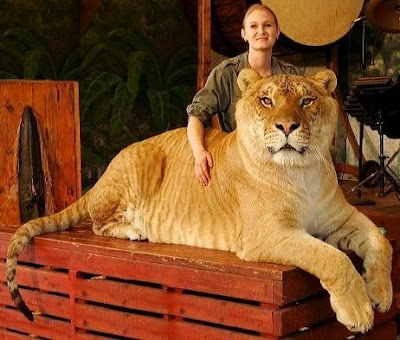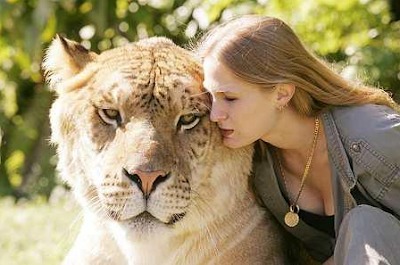 This information came to me at fag end of 2006 and since then I've always wanted to talk about and read about this amazing creature. I was awiting for an opportunity to write about this, but since I hadn't had an animal blog until Saturday, December 20, 2008, I couldn't write about it. If you have watched out the National Geographic Channel on December 30 2008 at 10 PM -11 PM, I am sure you know what a Liger is.
This information came to me at fag end of 2006 and since then I've always wanted to talk about and read about this amazing creature. I was awiting for an opportunity to write about this, but since I hadn't had an animal blog until Saturday, December 20, 2008, I couldn't write about it. If you have watched out the National Geographic Channel on December 30 2008 at 10 PM -11 PM, I am sure you know what a Liger is.
I liked him... simply liked him to the fullest extent! Liger is a cross breed creature between a lion and a tiger. Documentation of ligers spans back to over hundred years... at least the early phase of 19th century, in Asia. Well, though that was believed to be an accidental mix, but after that story had a its own twist.
 Researchers started thinking of creating ligers by cross breeding lions and tigers, when another accident set the world wide web abuzz! Hercules - the largest non-obese cat on the Earth cam into being to rule the Jungle Island in Miami. The Guinness Book of World Records recognized 900 lbs Hercules as the largest cat on Earth. When only 3 years of age, Hercules weighed 900 lbs (408.25 kg). Chyna, the trainer of the Parrot Jungle's Liger, Hercules, said that Hercules was a result of an accident... not any deliberate approach or artificial insemination. Over 11 feet tall Hercules eats about 20 pounds of meat every day. At his three years of age, Hercules was featured on the Today Show, Good Morning America, Anderson Cooper 360, Inside Edition.
Researchers started thinking of creating ligers by cross breeding lions and tigers, when another accident set the world wide web abuzz! Hercules - the largest non-obese cat on the Earth cam into being to rule the Jungle Island in Miami. The Guinness Book of World Records recognized 900 lbs Hercules as the largest cat on Earth. When only 3 years of age, Hercules weighed 900 lbs (408.25 kg). Chyna, the trainer of the Parrot Jungle's Liger, Hercules, said that Hercules was a result of an accident... not any deliberate approach or artificial insemination. Over 11 feet tall Hercules eats about 20 pounds of meat every day. At his three years of age, Hercules was featured on the Today Show, Good Morning America, Anderson Cooper 360, Inside Edition.  He also found a space in a Maxim magazine article in 2005.
He also found a space in a Maxim magazine article in 2005.Sinbad, another giant Liger marked his name in the world of wild! 900 lbs Sinbad is the result of a pre-planned mixing of genes of a lion and a tiger. Liger Sinbad was over 100 times the size of the domestic cats and weighes almost twice
 the natural weight of a tiger or a lion; he is still growing! Dr. Mahamayavi Bhagavan Antle (shortly called Dr.Bhagavan Antle) is the trainer of Sinbad. He is also the founder and director of T.I.G.E.R.S - The Institute of Greatly Endangered and Rare Species.
the natural weight of a tiger or a lion; he is still growing! Dr. Mahamayavi Bhagavan Antle (shortly called Dr.Bhagavan Antle) is the trainer of Sinbad. He is also the founder and director of T.I.G.E.R.S - The Institute of Greatly Endangered and Rare Species.Let's see what a Liger actually is...
 Liger is a hybrid creature bred by combining the genes of a male lion and a female tiger.... not the reverse. The anomaly of a missing growth-inhiniting gene in Ligers causes ligers to grow to an incredibly gigantic size, even dwarfing the lion father and tiger mother.
Liger is a hybrid creature bred by combining the genes of a male lion and a female tiger.... not the reverse. The anomaly of a missing growth-inhiniting gene in Ligers causes ligers to grow to an incredibly gigantic size, even dwarfing the lion father and tiger mother.  The skull can grow as large as 40% larger tha the skull of the lions and tigers. That's what happened to both Hercules and Sinbad. This amazing creature looks like a king size lion with faint tiger like stripes.
The skull can grow as large as 40% larger tha the skull of the lions and tigers. That's what happened to both Hercules and Sinbad. This amazing creature looks like a king size lion with faint tiger like stripes.Quick facts about History of Ligers...
A well known painting of a couple fo liger cubs had been made by the artist Étienne Geoffroy Saint-Hilaire (1772−1844), which documents the presence
 of ligers even those days. Evidences of Liger cubs born in 1824 had been proved by an engraving made by G.B. Whittaker in the year 1825. Traces of Ligers could also be found in a native style 19th Century painting that depicted parents and their three liger babies along with their trainer. So Liger is nto a new story! A couple of liger babies born in 1837, had been exhibited before the King William IV and his successor Victoria.
of ligers even those days. Evidences of Liger cubs born in 1824 had been proved by an engraving made by G.B. Whittaker in the year 1825. Traces of Ligers could also be found in a native style 19th Century painting that depicted parents and their three liger babies along with their trainer. So Liger is nto a new story! A couple of liger babies born in 1837, had been exhibited before the King William IV and his successor Victoria. December 14, 1900 and May 31, 1901 have always been a memorable day for the Liger lovers, because on these days zoologist James Cossar Ewart recieved two letters from Carl Hagenbeck, informing about details of ligers born at the Hagenbeck's Tierpark in Hamburg in 1897, along with the photographs of the liger cubs. Naturalist Mr Carl Hagenbeck was the breeder of the ligers, and came to fame by successfully bringing them up into two great giant Ligers.
December 14, 1900 and May 31, 1901 have always been a memorable day for the Liger lovers, because on these days zoologist James Cossar Ewart recieved two letters from Carl Hagenbeck, informing about details of ligers born at the Hagenbeck's Tierpark in Hamburg in 1897, along with the photographs of the liger cubs. Naturalist Mr Carl Hagenbeck was the breeder of the ligers, and came to fame by successfully bringing them up into two great giant Ligers.
Click on each of the pics on the right and view the larger image. Pics have been collected from the net.
Stay tuned... I want to talk more about Ligers. Till then check out these amazing Liper clips:
A Million thanks to Metacafe for this Liger Video clip
Liger - Awesome video clips here
A Million thanks to YouTube for these Liger Video clip














